Astroneer beginner's guide: how to play, crafting lists and more!
Astroneer is out now for Xbox One and Windows 10 in Preview, and while awesome, it's also a little confusing.
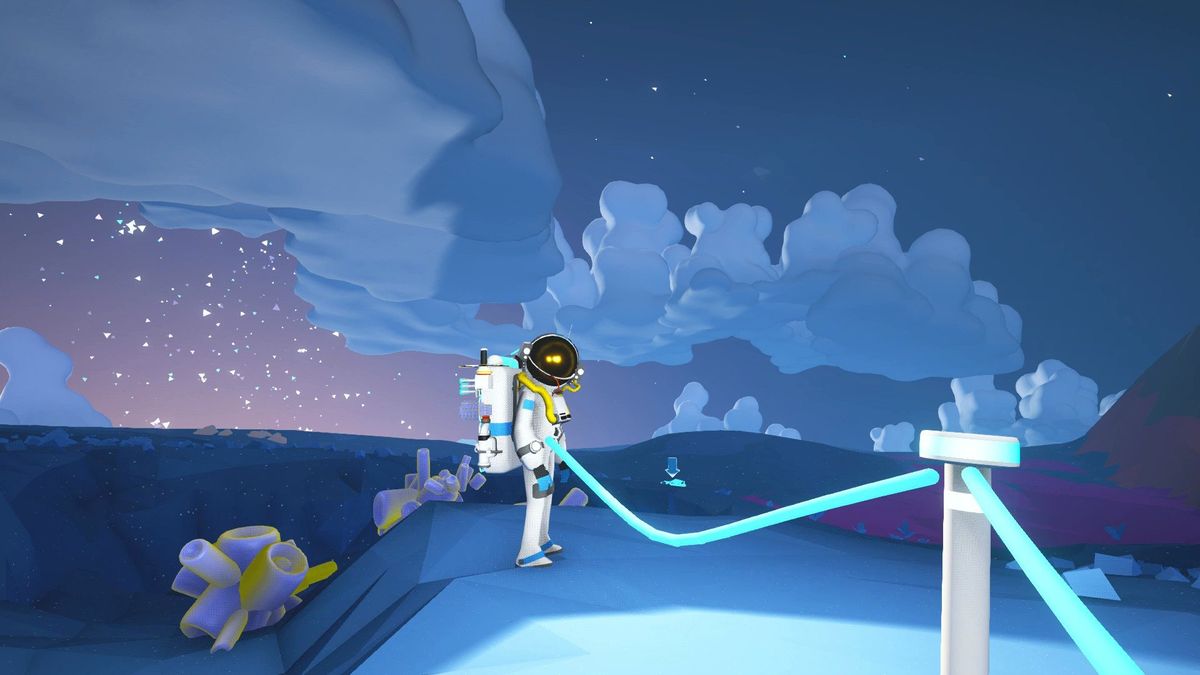
If you, like me, were struggling to get to grips with the Astroneer, these gameplay tips should help you get started in your budding career as space adventurer extraordinaire.
Update 12/25/2016: Extra tips on space travel and secondary planet colonization!
What is Astroneer?
Astroneer is an Xbox Play Anywhere title for consoles and PC. It's also available on Steam. The game is in a pre-Alpha state right now, so expect bugs, missing content, and other anomalies. However, even in this early state, it's an intriguing game.
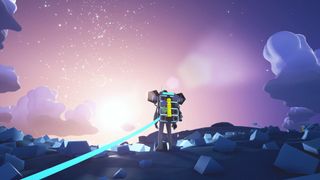
There's no real goal in Astroneer. Like Minecraft, gameplay revolves around exploration, crafting, and personal progression. You can build a base, shape terrain as you see fit, get upgrades and colonize an infinite amount of procedurally generated worlds.
The game is thin on tutorials right now, which is why we're here to give you some tips and an overview of what to expect on your journey through the stars.
Read our full Astroneer early impressions
Ground control to Major Nelson
On Xbox One especially, the control schemes for Astroneer are a little puzzling. Here's what you need to know.
Get the Windows Central Newsletter
All the latest news, reviews, and guides for Windows and Xbox diehards.
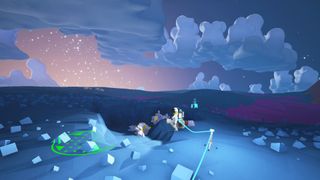
Astroneer has a few different control states, which can be confusing at first. One for the character, one for the cursor, and another one for the terrain morphing gun.
- General movement: With your terrain shaper holstered, the controls are pretty standard for a third-person game. Left joystick to move, right joystick to look, A button to jump. On PC, it's right click to move the camera, W key to move forward, and Space to jump.
- Shape Terrain: Press X on your controller or E on your keyboard to deploy and holster your terrain shaping tool. While deployed on Xbox, you lose access to the camera controls on the right joystick. Instead, the right joystick now aims the terrain tool. The left and right bumpers toggle between different terrain shaping modes, including dig terrain, add to terrain and flatten terrain. Use the ALT and CTRL keys to alternate between modes on PC. Use the right trigger or left click to fire. Make sure you holster your terrain tool after you're finished with it to get access to the regular movement controls.
- Cursor Mode (Xbox Only): Hold down the left trigger to enable cursor mode. This allows you to manipulate objects in the world, click buttons in your base, and move things into your backpack. Press the right trigger to pick up, drop, and snap items into place. Cursor mode also works on the main menu for selecting different save files.
- Back pack: Press Y on Xbox or the Q key on PC to toggle the view of your backpack. On Xbox, viewing your backpack enables Cursor Mode automatically, so right trigger becomes your select button. Click on the orange arrows at the bottom to craft field equipment such as tethers, solar panels, and more.
- Tethers: Tethers are your lifeline to your oxygen and power supply, you can place one by pressing down on the D-pad or T on a keyboard. You need to craft them first, though. More on that below.
- View Controls: Although they aren't very clear at present, press the view key on your controller to be reminded about the controls at any time, or via the pause menu.
Getting started
So you just landed on your first randomly generated planet. All you have is your terrain shaper, your space pod, and your backpack, but it's easy to get started.

The first resources you need are Resin and Compounds. Resin allows you to build basic structures, while compounds allow you to craft all important tethers.
- Be aware of your oxygen level, represented by a blue bar on the top of your backpack. If it hits zero, you die!
- Craft tethers using compounds as your first priority. Compounds are represented in the world as grayish blobs and occur in abundance all over the map. Venture carefully away from your space pod to see if you can find some.
- Use the terrain shaper to vacuum up materials. Once you have found and recovered a stack of compounds, go into your backpack, and select the orange buttons with the right trigger until you find the option to craft some tethers.
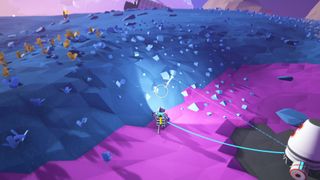
- Link tethers to your base to create an oxygen lifeline. Having lines of tethers makes exploration far easier until you research other ways to breathe. Link them together by pressing down on the D-pad or T on your keyboard.
Now that you know what you need to do to explore the world, the next step is building your very own colony.
- You need resin to craft new base modules, so make sure you have some in your backpack. Spiky, tube-like structures represent resin, and they occur abundantly in the overworld.
- When you have three stacks of resin, you can craft a new base module.
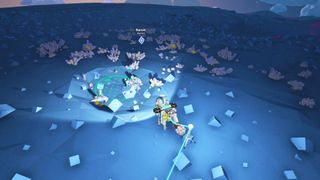
- Go to your home pod, and enter cursor mode with the left trigger if you're on Xbox. Extend a connector from your base with right trigger or left click if you're on PC.
- Right now, you can't destroy existing units, so make sure you add extra connectors before turning them into a module. You can add between three and five links per connector, depending on space.
- Select the edge of a connector to add another connector, or place two resin stacks on top to turn it into a module. You can move the resin from your backpack manually, but clicking or hitting the right trigger in cursor mode will send all the needed materials instantly.

- Once you have a module, you can use the cursor to select orange buttons to cycle through different types of units. A Research Unit and Smelter are the easiest, as the materials required are very common.
Space colonization!
Now that you have a smelter and a research facility, the next steps are managing your base and finding even rarer items and materials. Astroneer has no central goal as of yet. The game predominantly revolves around exploration and crafting, but eventually it will expand into a far richer, deeper experience if System Era Softwork's goals are met. Here are some of the main things you can build so far, we'll add more as we discover them!
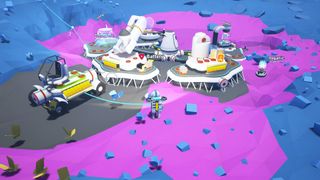
Building List (so far)
- Research: Placing a research module in your colony allows you to randomly unlock new units and equipment in exchange for power and research objects. Research objects can be found everywhere, and need to be lifted using cursor mode. You can find them in abandoned space wrecks, attached to subterranean alien plants, and beyond. They have to be dragged back to your base manually, so be ready for a trek. Research objects also grant rare materials occasionally. It's worth building a Research unit near to the exit of your mine.
- Smelter: This unit allows you to turn ores into metal bars, needed for building more complex structures. Ores are typically found by mining in caves underground, but they can also be scavenged from wrecks and probes above.
- Vehicle Bay: This unit allows you to 3D print vehicles, including a space buggy, seating for the buggy, trailer modules and more. Space buggies are modular with solar panels and other objects.
- Printer: The printer is a more heavy-duty version of the one on your backpack, allowing you to build larger solar panels, and other objects discovered from your research unit.
- Trade platform: Allows you to exchange resources. Build this next to a fuel condenser to convert solar power into hydrazine, which can then be traded easily for other items you need.
- Fuel Condenser: Allows you to convert power into hydrazine fuel in huge amounts. This can be traded, or used with your shuttle for travelling to, and colonizing other worlds.
We'll add more buildings to this list as we discover them, and as System Era Softworks add them.
Maintain a power grid
Beyond oxygen, the other resource you must manage is power. Your backpack has a large orange glowing bar up the center, which powers your Astroneer's lights, as well as the terrain shaper. It will regenerate slowly over time, but if you maintain a decent power grid and stay tethered, it will regenerate much more quickly.
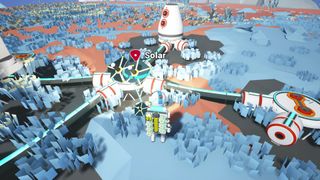
- Craft solar panels in your backpack, you can then attach them to the top of your backpack, granting power in daylight.
- Use a wind turbine to generate power during storms.
- Generators can turn organic matter into power when there's no sunlight or wind available.
- Harvest power from orange-glowing micro-organisms underground and in the field.
- Batteries can store excess power for use when there is no available sunlight, wind, or generator power available.
You can attach these power generators to vehicles and buildings to keep them powered, each of which has their own orange bar power requirements. Sometimes when a building function doesn't activate, it might be because there's a slither of power missing. Power generated can also feed your backpack via the tether, making mining excursions a little easier.
Mining
A big part of Astroneer is mining, as some of the rarest materials occur more often underground. You need a smelter to turn raw ores into metal bars for crafting more complex components, and finding them can be difficult (and dangerous)! Here are a few tips.
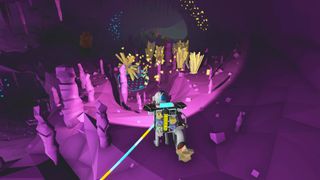
- Once you have unlocked a Fuel Condenser and a Trade Platform, trading hydrazine fuel for any items you need makes mining a little redundant. But until then, you'll have to get digging!
- It might not be necessary (or even a good idea) for you to dig straight down, like in Minecraft. Caves often occur naturally in Astroneer and provide a steady ramp for bringing in a tether line.
- Speaking of which, make sure you take plenty of tethers so you don't suffocate.
- Also consider taking batteries, and making sure your base is sufficiently stocked up on power. Mining depletes your basic energy level quite quickly.
- Be careful not to mine at your feet. If you fall into a lower chasm, you could become separated from your tether, and die alone in the dark.
- In caves, you will find copper ore, aluminum ore, and titanium ore. These items are used for more complex structures like the vehicle bay and need to be turned into metal bars first at the smelter.
Space travel
This is what space exploration looks like in #Astroneer. My first flight! #XboxOne pic.twitter.com/e9g4q2EQA2— Jez (@JezCorden) December 19, 2016
Eventually, you will have a Vehicle Bay and enough resources to build a shuttle and leave your base world. Here are a few things I have learned about the process so far.
- Make sure you have a Fuel Condenser built so you can properly stock your shuttle with fuel. I unfortunately didn't have enough fuel to return to my home world after my maiden voyage. D'oh!
- Make sure you have researched and crafted a Habitat before leaving your home world, this will help you set up a new base on a new planet.
- Make sure you take a bunch of tethers and resin stacks with you to help get established. Secondary worlds sometimes have less resources.
- Try to bring the materials to set up a Trade Platform on your second world, you never know what sort of materials you might be missing out on.
- Click on the icon above your ship to view the local star system. The circle around the edge shows how far your fuel will take you. Try not to fly too far away if you intend on getting back home in one piece. Make sure to stock up your backpack with fuel for this reason too!
- Landing seems a little buggy at the moment, but if you do successfully select a new planet and an appropriate landing spot, you can begin building a new base. I already discovered new plants and objects after my first flight.
Explore and have fun!
Astroneer might be in pre-Alpha Game Preview with many bugs, missing features, and so on, but the raw potential in this humble title reminds me of the early Minecraft days more than most titles attempting this development model.
Astroneer has a vibrant community subreddit already, and the developers are actively communicating about upcoming fixes and features that Game Preview players will enjoy over the coming months.
Astroneer is a $19.99 buy-once Xbox Play Anywhere title, and if you're unsure, it also has a free trial across both platforms. It's well worth checking out.
- Download Astroneer from the Windows Store
- Astroneer gameplay impressions (so far)

Jez Corden is the Executive Editor at Windows Central, focusing primarily on all things Xbox and gaming. Jez is known for breaking exclusive news and analysis as relates to the Microsoft ecosystem while being powered by tea. Follow on Twitter (X) and Threads, and listen to his XB2 Podcast, all about, you guessed it, Xbox!